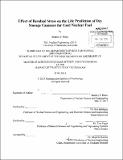Effect of residual stress on the life prediction of dry storage canisters for used nuclear fuel
Author(s)
Black, Bradley P. (Bradley Patrick)
DownloadFull printable version (22.59Mb)
Other Contributors
Massachusetts Institute of Technology. Department of Nuclear Science and Engineering.
Advisor
Ron Ballinger.
Terms of use
Metadata
Show full item recordAbstract
Used nuclear fuel dry storage canisters will likely be tasked with holding used nuclear fuel for a period longer than originally intended. Originally designed for 20 years, the storage time will likely approach 100 years. These canisters are fabricated from rolled and welded austenitic stainless steel plate. Most of the storage facilities are located on coastal or brackish water sites with environments containing moisture and chloride ions that can cause stress corrosion cracking (SCC). Residual stresses from the welding process provide the tensile stress for crack initiation and propagation which could eventually compromise canister integrity, allowing the release of radioactive material to the environment. If it is assumed that a tensile stress, predominantly from welding, is constant through the material thickness, this would suggest that failure will be initiation controlled. However, prior studies and practical experience indicate that residual stress varies as a function of depth into a welded material, and that stresses can decrease to zero or even go into compression. This would indicate that at some point, crack propagation could be slowed or even be stopped. In order to predict the time to failure of canister material by stress corrosion cracking, it is therefore necessary to know the actual residual stress distribution through the thickness of canister welds. This thesis investigates dry storage canister designs, canister welds, and contributing factors to residual stress, as well as prior studies of residual stress in welded stainless steel piping and chloride stress corrosion crack propagation rates. From this investigation, an estimate is made for the likely residual stress distribution in a typical canister weld, and the effect of residual stress on canister life prediction is examined. The analysis suggests that residual stress distribution has a tremendous impact on a canister's projected time to failure, and that residual tensile stresses in the heat-affected zone of canister welds could become low enough to result in crack arrest.
Description
Thesis (S.M.)--Massachusetts Institute of Technology, Dept. of Nuclear Science and Engineering, 2013. Cataloged from PDF version of thesis. Includes bibliographical references (pages 123-133).
Date issued
2013Department
Massachusetts Institute of Technology. Department of Nuclear Science and EngineeringPublisher
Massachusetts Institute of Technology
Keywords
Nuclear Science and Engineering.